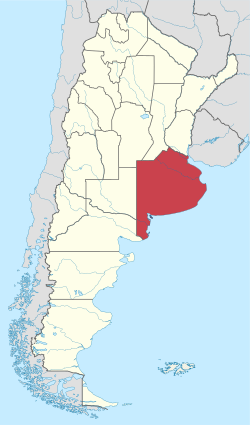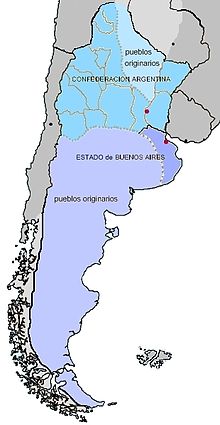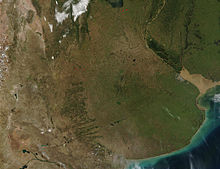Buenos Aires Province
| Basic data | |
|---|---|
 ( Details ) |
 ( Details ) |
| Capital: | La Plata |
| Surface:
- Total |
Rank 1 of 24 307,571 km² |
|
Population :
- Total 2010 |
Rank 1 of 24
15,625,084 inhabitants |
| ISO 3166-2 code: | AR-B |
| politics | |
| Region : | no |
| Structure: | 135 partidos |
| Gobernador: | Maria Eugenia Vidal |
| Website of the Province of Buenos Aires | |
The Province of Buenos Aires ( Provincia de Buenos Aires ) is located in the east of Argentina in the middle of the fertile Pampa plain. With more than a third of the total population of Argentina, it is the most populous and also the largest province in the country in terms of area. In the northeast of the province, on the Río de la Plata , lies the capital of the Republic of Argentina, Buenos Aires , which, however (unlike its suburbs) is not part of the province. The capital of the province is La Plata , located in the Buenos Aires metropolitan area .
Geography and climate
The province is bordered by Santa Fe and Entre Ríos to the north, Uruguay to the east, the Atlantic Ocean to the southeast, Río Negro to the south, La Pampa to the west and Cordoba to the northwest .
Geographically, it belongs entirely to the Pampa region, with the exception of the extreme south, which belongs to Patagonia . The most striking mountain ranges are the Sierra de la Ventana (up to 1100 meters) and the Sierra de Tandil (up to 600 meters).
The climate is temperate and oceanic, with warm summers and mild winters, as well as consistently high humidity and high levels of precipitation all year round. It gets drier to the west and southwest.
Population and cities
About a third of the country's population live in the province. It is particularly concentrated in the area around the state capital Buenos Aires , the so-called Gran Buenos Aires, which does not belong to the province, but forms a separate member state ("autonomous city") . Two thirds of the provincial population live there. The largest city in the province is the provincial capital La Plata (740,000 inhabitants), followed by the seaside resort of Mar del Plata (619,000). The largest individual cities in the suburban belt of Buenos Aires are Vicente López , Merlo and Quilmes , each with around a quarter of a million inhabitants, other populous cities in the interior of the province are in particular Bahía Blanca (299,000), Pilar (226,000) San Nicolás de los Arroyos (125,000), Tandil (101,000) and Zárate (99,000).
The majority of the population consists of descendants of Spaniards , Italians and British , the latter mainly found in the south of the province. Notable Indian settlements there possibly in the extreme south ( Tehuelches , almost 100% mestizisiert ).
history
From a European point of view, the provincial area was entered for the first time by Juan Díaz de Solís in 1516. However, early settler activities failed, for example Pedro de Mendoza , who was active on the coast of the Río de la Plata in 1536, had to give up his settlement of Santa María del Buen Ayre again in 1541 . The final settlement of the province goes back to the founder of Buenos Aires, Juan de Garay , who set up an encomienda system in the area around the city in 1580 . Numerous up-and-coming cities emerged from the surrounding estancias in the north of today's province.
However, the province has only existed as an independent territorial unit since February 2, 1820. At that time, it comprised a much larger area than today: the entire central west to the Andes and all of Patagonia . Until the middle of the 19th century, however, apart from a few enclaves such as Carmen de Patagones , the troops loyal to the government controlled only the north of today's provincial area; the south and much of the central west were ruled by indigenous people.
Since the United Provinces of the Río de la Plata (1810 to 1835) had no central government with the exception of the brief period between 1826 and 1827, the Province of Buenos Aires, which at that time also included the city of Buenos Aires , was de facto an independent state within the provinces or the Argentine Confederation renamed in 1835. But it held a predominant position among the other provinces, so its governor was entrusted with the foreign policy of the loose confederation of states. Juan Manuel de Rosas in particular , governor between 1829 and 1832 and between 1835 and 1852, expanded these privileges and established a dictatorship, largely from which the other provinces were also largely influenced by the concentration of exports on the port of Buenos Aires and by Rosas' military interventions were dependent. At the same time, despite his central authority formally belonging to the federalists, he had no interest in a constitution or unification of the country. Finally, he was defeated by the federalist Justo José de Urquiza , governor of the Entre Ríos province , in the battle of Monte Caseros .
The province of Buenos Aires refused to take part in the constitutional congress initiated by the provisional head of state Urquiza for 1853, as it saw its supremacy endangered, and separated from Argentina in 1852. For a short time it was an independent state called Estado de Buenos Aires , but was not recognized by the other provinces. It was not until 1861 that the province of Buenos Aires rejoined the confederation, which was then renamed República Argentina , when they again fought against the government troops under Bartolomé Miter and the former President Urquiza withdrew in the even battle and left Miter the victory, on condition to rule his Entre Ríos province without intervention from Buenos Aires. Miter then became president of the reunified Argentina.
After troops loyal to the government had advanced far south until 1880 as part of the so-called Conquista del Desierto , a campaign against the Mapuche and Tehuelche , large parts of the territory were separated and in 1884 a number of national territories were established: La Pampa , Neuquén , Chubut , Santa Cruz and Tierra del Fuego . Only in the course of the 20th century were these also given provincial status.
In 1882, the city of Buenos Aires, which had previously been the capital of the province, was separated from it and at the same time declared the capital of Argentina. In the same year, the city of La Plata was founded as the new capital of the province .
In the course of the 20th century, the areas of the previously almost uninhabited southern and southwestern part of the province were also settled. From around 1890 onwards there was lively tourism on the Atlantic coast , while agriculture was expanded to include the rest of the province.
Political system
The currently valid constitution of the Province of Buenos Aires dates from 1994.
The legislature of the province is composed of two chambers, the Chamber of Deputies ( Cámara de Diputados ) and the Senate ( Senado ). The members of both chambers are elected for four years, with half being re-elected every two years. You cannot be a government employee at the same time. The two chambers usually meet separately and only meet together in certain special cases as the Asamblea Legislativa .
At the head of the executive branch of the province is the governor ( gobernador ), who is directly elected for four years together with the vice governor ( vicegobernador ). The election takes place together with an election of half of the MPs. A single consecutive re-election as governor or lieutenant governor is permitted. The lieutenant governor represents the governor if the governor is unable to exercise his office and, in the event of his death, dismissal or resignation, assumes the office of governor until the end of the regular term of office. If both the governor and the lieutenant governor are divorced, the first vice president of the Senate will temporarily take over their functions, but must immediately convene a meeting of the Asamblea Legislativa to elect an interim governor. He will exercise his office until the next upcoming date for the re-election of half of the MPs. Together with these, the governor and vice-governor will then be re-elected.
Administrative division
The province of Buenos Aires is administratively divided into 135 Partidos , which also function as units of local self-government and in this capacity are referred to as Municipios .
The Municipios each have an Intendente , who heads the executive, and a Concejo , which has between 6 and 24 members ( Concejales ) depending on the number of inhabitants . Both the Intendente and the Concejales are directly elected for a term of four years, with half of the Concejales being re-elected every two years. The elections take place together with the elections to the provincial parliament. The officials of the municipality may not hold offices in the executive, legislative or judicial branches at the level of the state or the province, nor may they be paid employees of the municipality or members of the police. Foreigners who have mastered the Spanish language, have lived in the municipality for at least two years and have paid taxes, have the right to vote and stand for election to the Concejo , just like Argentine citizens , but may not hold more than a third of the seats in the Concejo .
Unlike all other provinces in Argentina, Buenos Aires is not organized into regions. This is because the main function of the regions is to create an economic counterweight to Buenos Aires, which would be absurd in the metropolitan area.
See also: List of Partidos of the Province of Buenos Aires
economy
Almost the entire territory of the province is used for agriculture or is used for cattle breeding . In all cities there are agro-industrial companies that process the products. There is also a diversified industry around the big cities (automotive industry in General Pacheco near Buenos Aires, chemical industry in Bahía Blanca , steel industry in Campana). About 60 percent of the country's total industry is concentrated in this province.
Another important source of income is tourism , especially on the southern Atlantic coast of the province, where the five most important seaside resorts in Argentina are Mar del Plata , Necochea , Miramar , Villa Gesell and Pinamar . The region near the mouth of the Río de la Plata , the so-called Atlántida Argentina , with the holiday centers of San Clemente del Tuyú , Santa Teresita and Mar de Ajó is also important .
Web links
Coordinates: 36 ° 9 ′ S , 60 ° 34 ′ W



